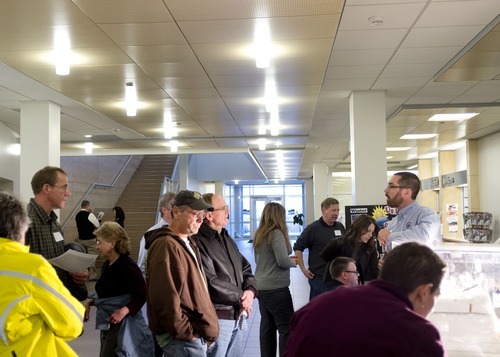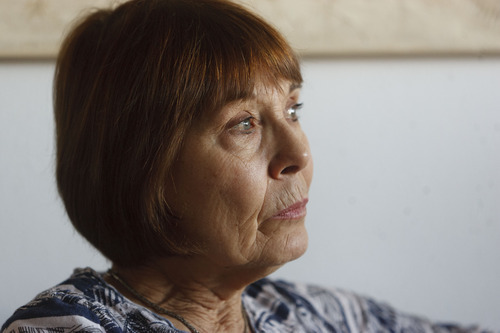This is an archived article that was published on sltrib.com in 2012, and information in the article may be outdated. It is provided only for personal research purposes and may not be reprinted.
Vernal • Sandy Hansen calls it the "ostrich approach," the way leaders are addressing the health impacts of the Uinta Basin's wintertime ozone problem.
She and her friends watch the daily pollution forecasts that began this winter. Other than that, there's not much out there to guide them on protecting their health when ozone pollution gets bad.
It comes down to simple things: Is it safe to walk the dogs on high-pollution days? Should recess be indoors, especially for children with asthma? Do energy field workers need to take precautions?
"They deny the health issues exist because they're so dependent on the gas patch surviving," said Hansen, who's been especially watchful of her health as she battles terminal kidney cancer.
"I don't want anybody to lose their job," she added. "I just want our kids to be able to breathe healthy air and to drink the water."
"I would like to see more communication between the government entities, the monitoring entities and the public," added Colleen Mandala, a fifth-generation basin resident.
So far the economic consequences of ozone pollution have gotten lots of the attention. The human consequences, not so much.
This winter, a cooperative of federal, state and local agencies and the energy industry is plowing more than $5.5 million into ozone studies. The goal, at least for some industry supporters within the state: protecting the region's booming oil and gas industry from new controls or sanctions that might be required by Washington, D.C., under the Clean Air Act.
Meanwhile, just a tiny fraction of the money is going to address ozone-related health issues. This winter, the Tri-County Health Department received $15,000 through a federal grant to mount an asthma-awareness campaign.
"We have educational literature to provide to the public on subjects such as wood-burning stoves, ozone and PM2.5," said Tri-County's public information officer Jeramie Tubbs, who noted in an email that her agency has useful links on its Web page. "However, there has been LITTLE public interest."
No one realized ozone was such a serious problem in the West's remote oil and gas lands until summer pollution monitors were left on accidentally through the winter a few years ago near Pinedale, Wyo.
Ozone is normally considered a summertime problem for big cities, but the numbers recorded in the Wyoming gas patch rivaled the worst summer pollution in urban areas. When monitoring started in Utah's oil and gas country two winters ago, the same trend emerged.
Last winter and the prior winter, readings in the Uinta Basin reached nearly double the levels considered "unhealthy" by the U.S. Environmental Protection Agency — they were about as high as the areas with the worst summer ozone pollution in the nation.
Ground-level ozone itself is an odorless, colorless gas. But, when it "cooks" in sunlight with other pollutants, it transforms into what we usually call smog.
In the basin, environmental officials noted that whenever snow covered the ground, the wind died down and a temperature inversion set in, the ozone spiked.
Levels reached 149 parts per billion last winter and 123 ppb the winter before, and the high level stuck around for days at a time whenever there was an inversion.
The EPA says more than 75 ppb is unhealthy not only for those who are most vulnerable — the very young, the very old and those with heart and lung problems — but also those who work hard in it outdoors. The high pollution might trigger an asthma attack for someone who already has trouble breathing, or it might cause what doctors describe as a sunburn on the lungs.
In December, the Denver regional administrator for the EPA wrote to Gov. Gary Herbert and said his agency might know as soon as next year whether the basin is out of compliance with the federal Clean Air Act. So far, the high temperatures and lack of snow cover on the basin landscape have kept ozone levels low this winter.
Meanwhile, the question about human health consequences remains a concern in Vernal.
A recent open house, hosted by the agencies working on the what's-causing-the-pollution study, did provide fact sheets about summertime ozone and wintertime particulate pollution, but since they apply to places like Salt Lake City rather than the basin, Vernal residents new to the subject might have been confused.
Michelle Hofmann, a pediatrician and founder of the health-advocacy group Breathe Utah, said she hopes to begin an outreach program in the basin in spring.
"A very little bit of information goes a long way," said Hofmann, who helped develop a symptom-tracking tool to be used in conjunction with ozone reports.
The tool helps parents and asthma sufferers take a personal approach to addressing ozone impacts. Once someone discovers what level causes them trouble, they can take useful steps to make sure that pollution doesn't harm their health or slow their activities, she said.
"It's a challenging public health message to get out there," she added. "We're talking about stuff no one wants to know."
Meanwhile, Hansen and her friends hope regulators are headed in the right direction with the attention they're giving to the ozone problem in Duchesne and Uintah counties.
"The public," Hansen said, "is ill-served by not knowing the truth."
Twitter: judyfutah —
Ozone and health
Federal law directs the U.S. Environmental Protection Agency to develop its pollution control regulations based on health-impact studies. Regulations on ozone are no different, although purists insist that the acceptable level of ozone should be zero because research suggests there are negative health impacts at even the smallest levels.
According to the EPA, people with lung disease, children, older adults and people who are active tend to be harmed most by high ozone pollution. Health impacts can include airway irritation, coughing, and pain when taking a deep breath; wheezing and breathing difficulties during exercise or outdoor activities; inflammation, aggravation of asthma and increased susceptibility to respiratory illnesses like pneumonia and bronchitis; and permanent lung damage with repeated exposures.
For more information about ozone, see the websites:
For Tri-County Health: http://www.tricountyhealth.com/AirQuality.html
From the Utah Department of Environmental Quality: http://www.deq.utah.gov/locations/uintahbasin/index.htm
Also, Breathe Utah has a step-by-step guide on creating an air pollution action plan: http://www.breatheutah.org/emergency-plan









